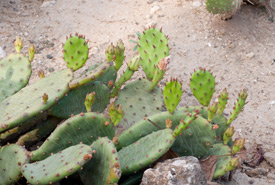
Eastern prickly pear cactus (Photo by Pany Goff/Wikimedia Commons)
Eastern prickly pear cactus
What does it look like?
The eastern prickly pear cactus is a perennial succulent cactus, with jointed, curved, flat green stems. Each of its segments is called a pad, and comes equipped with sharp spines and barbed bristles. Waxy yellow to bright gold flowers grow on the pad's edges. This species produces edible green fruit that becomes reddish-brown when ripened. The cacti can grow horizontally or vertically and reach heights of 0.5 metres.
Where is it found?
These plants grow in open, arid sandy areas that receive plenty of sunlight, such as sand dunes and open forests. They are unable to grow in completely shaded areas. In Canada, they exist only in two spots, and both are in southern Ontario: the cedar savannah habitats in Point Pelee National Park and Fish Point Provincial Nature Reserve on Pelee Island. While extremely rare in Canada, they are abundant in central and eastern United States.
How does it reproduce?
The eastern prickly pear cactus can reproduce either sexually or asexually. Its flowers are generally pollinated by insects, and it produces fruit with seeds that small mammals and birds disperse. They can reproduce asexually when pads detach themselves from parent plants and take root.
What threats does it face?
Although all regions where eastern prickly pear cactus occur are protected, it is threatened by habitat loss resulting from winter storms and eroding shoreline. Invasive species, such as spotted knapweed and white sweet clover, outcompete the cacti.
What is its conservation status?
The Committee on the Status for Endangered Wildlife in Canada has assessed the eastern prickly pear cactus as endangered in Canada.
What is NCC doing to protect habitat for this species?
Although the eastern prickly pear cactus is not found on any NCC properties, NCC is controlling the populations of non-native invasive plant species, such as the common reed, on Pelee Island properties. This reduces the chances of this species spreading to nearby areas where the eastern prickly pear cactus grows, such as sand dunes and beaches.





